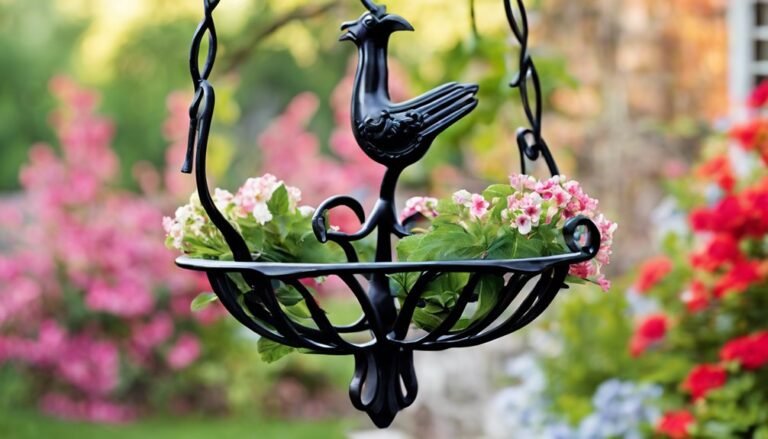Best Hooks for Tiled Walls
When it comes to the best hooks for tiled walls, you need to take into account material compatibility and weight capacity. Adhesive hooks are great for easy installation, while suction cup hooks offer a damage-free, temporary solution. If you prefer something more permanent, wall-mounted options require drilling but can hold heavier items securely. Make sure to choose rust-resistant materials and clean the surface well before adding your hooks. Stick around to find out more about ideal installation techniques!
Understanding the Challenges of Hanging on Tiled Walls
When you're trying to hang items on tiled walls, it can be tricky due to the surface's unique characteristics. First, you need to take into account tile surface considerations, like the texture and finish. Glossy tiles might look nice, but they can make it hard for hooks to adhere properly. Next, think about hook material compatibility. Not all materials work well with tile; metal hooks may corrode, while plastic ones might not hold up under weight. Choosing the right adhesive or mounting option is essential, too, as some adhesives may damage the tile upon removal. By understanding these challenges, you can find creative solutions that allow you to hang your items securely, giving you the freedom to personalize your space without worry.
Types of Hooks Suitable for Tiled Surfaces
Choosing the right type of hook for tiled surfaces can make all the difference in securely hanging your items. For a stylish touch, decorative hooks are fantastic options; they not only add flair but also come in various materials like metal, plastic, and wood. Metal hooks offer strength and durability, making them ideal for heavier items. If you prefer a lightweight solution, plastic hooks can be an excellent choice, especially for decorative elements. Wooden hooks bring warmth and charm to your space, fitting well in more rustic or cozy settings. When selecting hooks, consider the weight of what you'll hang and the hook materials to guarantee they adhere well to your tiles without damaging them. Enjoy the freedom of decorating your space!
Adhesive Hooks: Pros and Cons
Adhesive hooks are a popular choice for tiled walls because they're incredibly easy to install—no drilling or tools required. However, it's important to keep in mind that they do have weight capacity limitations, so you'll want to take into account what you plan to hang. Let's take a closer look at the benefits and drawbacks of using adhesive hooks in your space.
Easy Installation Process
Although many people appreciate the convenience of adhesive hooks for tiled walls, weighing their pros and cons is essential before diving in. The installation process is straightforward, often requiring minimal installation tools. Here's what you should consider:
- No drilling required: Save your tiles from damage.
- Variety of hook materials: Choose from plastic, metal, or specialty options.
- Quick application: Just peel and stick for an instant solution.
- Removable: Easily change your mind without leaving a mark.
While adhesive hooks offer freedom and flexibility, it's important to understand their limitations. Make sure to select the right hook materials for your needs and always follow the manufacturer's guidelines for the best results. Enjoy your hassle-free decor!
Weight Capacity Limitations
While adhesive hooks can be a convenient option for hanging items on tiled walls, it's crucial to take into account their weight capacity limitations. Most adhesive hooks come with specific load bearing limits, often ranging from a few ounces to a few pounds. When choosing your hooks, consider weight distribution considerations—how the weight of your items is spread across the hook. For heavier items, opt for hooks designed to handle more weight and verify they're properly adhered to the surface. Also, remember that exceeding the load limits can lead to failure, potentially damaging your walls or causing accidents. Being mindful of these factors helps you maintain a beautiful and functional space without compromising safety.
Suction Cup Hooks: A Temporary Solution
Have you ever needed a quick and easy way to hang items on tiled walls without making a permanent commitment? Suction cup hooks are your go-to solution! They offer flexibility and ease of use, but be mindful of their suction cup longevity and temporary hook effectiveness.
Here are some benefits to evaluate:
- No damage: They won't leave marks on your tiles.
- Easy installation: Just press and stick!
- Versatile: Perfect for bathrooms or kitchens.
- Cost-effective: An affordable option for short-term use.
Just remember, suction cups may not hold heavy items for long, so check them regularly. Enjoy the freedom of rearranging your space without the worry of holes or damage!
Wall-Mounted Hooks: Drilling vs. No-Drill Options
If you're looking for something more permanent than suction cup hooks, wall-mounted hooks are a fantastic option. You can choose between drilling techniques or no-drill options based on your needs. Drilling provides a strong hold, allowing you to use heavier hook materials like metal or durable plastic. Just make sure you have the right tools and take care not to damage your tiles.
On the other hand, no-drill options, like adhesive or magnetic hooks, offer flexibility and ease of installation. They're perfect if you want to avoid permanent changes or if you're renting. Both methods have their benefits, so think about what suits your lifestyle best. With the right choice, you'll enjoy the freedom of a well-organized space.
Tips for Installing Hooks on Tiled Walls
When installing hooks on tiled walls, it's essential to choose the right type of hook that fits your needs and the tile's surface. Proper surface preparation can make a big difference, ensuring the hooks adhere well and last longer. Finally, using the correct installation methods will help you avoid damage and keep your tiles looking great.
Choosing the Right Hooks
Choosing the right hooks for your tiled walls can make all the difference in both functionality and aesthetics. When you're selecting hooks, consider the following factors to guarantee they meet your needs:
- Hook materials: Opt for rust-resistant options like stainless steel or plastic for durability.
- Weight capacity: Check the load limits to confirm they can hold your items securely.
- Design aesthetics: Choose hooks that match your decor style, whether it's modern, rustic, or minimalist.
- Installation method: Some hooks require drilling, while others use adhesives—pick what works best for you.
Surface Preparation Techniques
Before you start installing hooks on your tiled walls, it's essential to prepare the surface properly for a secure hold. Begin with thorough surface cleaning; use a gentle detergent solution to remove dirt and grease. This'll guarantee your hooks adhere well. Depending on tile types—ceramic, porcelain, or glass—you might need specific cleaners or tools to avoid scratches. After cleaning, let the surface dry completely. This step is critical; moisture can weaken the adhesive bond of your hooks. If you're dealing with textured tiles, consider using a stronger adhesive to compensate for the uneven surface. With a clean, dry, and prepared wall, you'll set the stage for a successful hook installation that stands the test of time.
Proper Installation Methods
Although installing hooks on tiled walls may seem straightforward, a few key steps can guarantee they're securely mounted and functional. To achieve the best results, make certain you follow these tips:
- Choose the right hooks: Select hooks designed for tile surfaces to ensure maximum hold.
- Gather installation tools: You'll need a drill with a tile bit, adhesive, and a level for accuracy.
- Mark your spots: Use a pencil to mark where you want your hooks, ensuring they're evenly spaced.
- Drill carefully: When drilling, apply gentle pressure to avoid cracking the tile.







